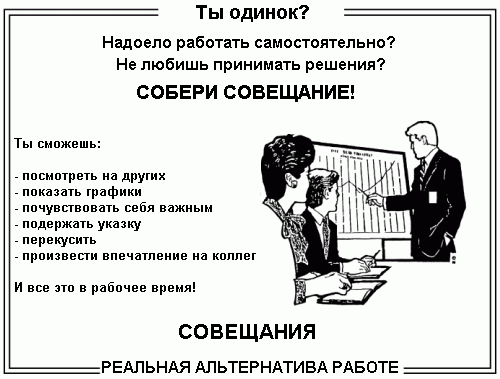Effective meetings

So, we come to work and, voila, after 40 minutes, a meeting (meeting) is scheduled. The topic “Discuss the solution of current problems”, duration 1 hour, in the list of invited 8 people. 40 minutes of anxious waiting and we are on the spot - we greet our colleagues, tune in a constructive way. The organizer appears, cheerfully starts and ... within five minutes we realize that we are losing time again. It seems that the problems discussed are quite real, and there are enough people present, but the meeting is steadily turning into a pointless discussion.
I am sure that this situation is familiar to many and much has been written about what kind of meetings should not be. And yet, there are problems that are risky to solve alone and without a meeting can not do. This article is about how to spend your and other people's time effectively in these cases.
Signs of an effective meeting
An effective meeting has:
- Need
- purpose
- Plan
- Organizer
- Time frame
- Minimum number of participants
- Result
Need
The organizer must be very clear that the meeting is expensive. An hourly rally pulls a person out of work for at least an hour and a half. It is impossible to instantly switch between the work-meeting-work, it takes time to enter the context.
')
Suppose that the meeting participant hour is $ 25. The above rally about current problems, in this case, will cost 8 x 1,5 x 25 = $ 300. Obviously, there should be an acute enough need under the meeting to justify these costs.
purpose
Everything we do should have some kind of goal. It sounds crazy, but the vast majority of meetings do not have it. Often, the organizer is not able to explain why we are gathered. And if the goal is not, then it can not be achieved.
A good goal is a SMART — a goal that determines the result. “Discussing current problems” is a bad goal, as it sets the goal of shaking the air. “Deciding on which server to do load testing” is a good goal.
Plan and Organizer
The agenda of the meeting might look like this:
Plan:
1 Describe the problem [Ivan].
2 Suggest 3-5 solutions [Ivan, Peter, Maria].
3 Choose the best solution [Ivan, Peter, Maria].
4 Assign responsible for the implementation of [Ivan].
Objective: Decide on which server to conduct load testing.
Organizer: Ivan.
Duration: 20 minutes.
Usually 3-5 points of the plan is enough to provide a general understanding of what will happen. Responsibilities of the organizer - to ensure adherence to the plan. He has the right to speak, deprive words and in every possible way direct the meeting in the right direction.
Time frames and participants
It is safe to take the rule that the effectiveness of the meeting is inversely proportional to its duration and the number of participants. Managing meetings longer than 30 minutes with 5+ participants is already very difficult. If the amount of information is so large that it takes an hour or more, it is better to split it up. And, of course, it is good to think whether such expenses of time are justified.
Result
As already mentioned, there is no goal - no result. The vast majority of meetings ends in nothing. One said “must do,” the others agreed and dispersed. Who and when will do, decide somehow later. The task of the organizer to lead the meeting to a specific result. This can be a document, a specific task, or a recorded solution.
An example of a good result:
“It was decided to carry out load testing on the customer's UAT server. Ivan today will request access and send it to Peter. Peter will set up the server until 15-00 on Thursday, after which he will report the results by mail. ”
Total
Effective meetings are not easy. This explains the many hours spent sitting on wasted rallies. There is even a special profession meeting facilitator - a person who helps conduct meetings efficiently. But, even simply following the above points, over time your rallies will be shorter, richer and more productive. Successes.
Source: https://habr.com/ru/post/114061/
All Articles